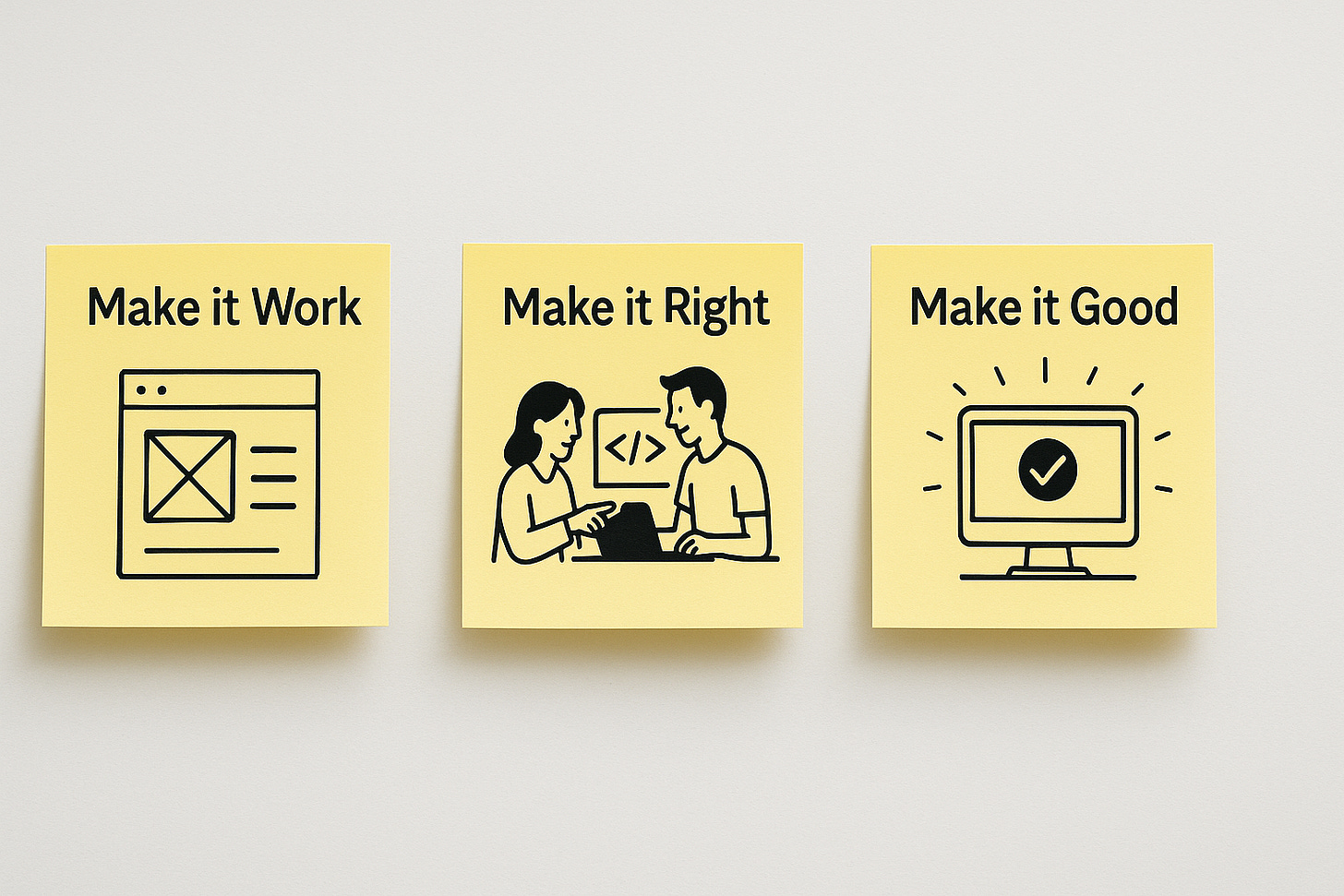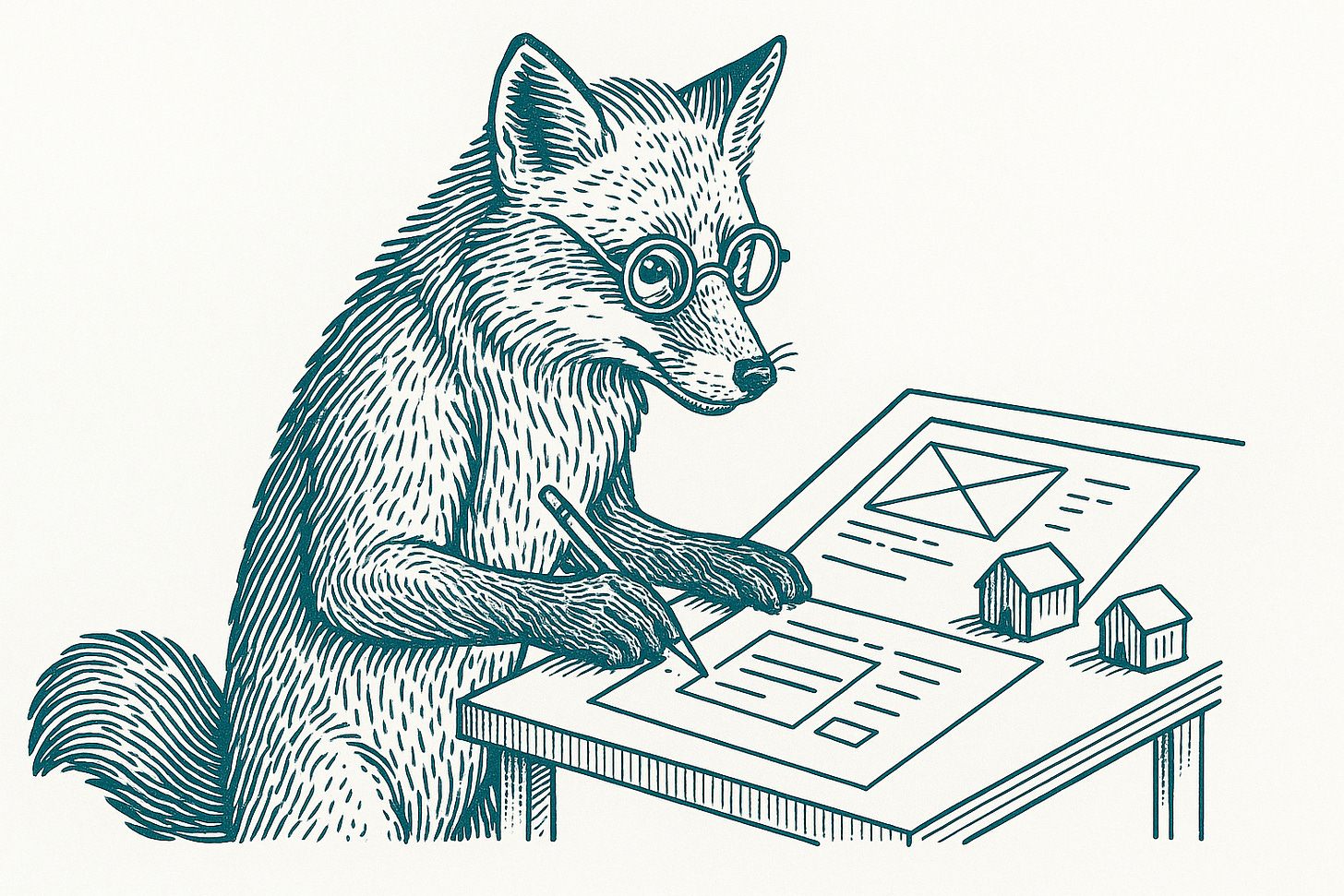Designers Building the AI Prototype
AI is changing how products are built, but there's a blind spot: designers are still standing on the sidelines, even as the tools finally let them take center stage.
Over the last week, I’ve been captivated by the idea that Designers are best positioned to leverage AI on development teams.
AI is changing how products are built, but there's a blind spot: designers are still standing on the sidelines, even as the tools finally let them take center stage. Most teams treat AI as the domain of engineers and data scientists, and for designers, this technical barrier makes AI seem unapproachable and out of reach.
On the other end of the spectrum, there’s a subculture of “vibe coding” and hustle culture. Small teams or solo builders are cranking out rough AI prototypes, often without rigorous product development practices.
But even as these experiments multiply, they rarely result in thoughtful, user-centered products—often sacrificing quality and vision for speed. This highlights a gap: while engineers and hackers can rapidly iterate on technical possibilities, what's too often missing in the process is the guiding hand of design.
I’ve noted that the teams closest to the customer are best positioned to deliver real value. Designers, more than anyone, bridge the gap between WHAT a customer wants and HOW the business delivers it. This makes designers uniquely well-placed to drive and shape how AI is applied to solve practical, customer-centric problems.
What’s new, and what too few teams have noticed: the AI toolchain has finally become accessible enough that designers themselves can prototype, test, and iterate—without waiting for engineering or hunting down a Python wizard.
Design-Driven Product Development
Over the years, I’ve formed a straightforward operating model for developing great products on engineering teams:
On most teams, "Make it Work" means building quick, rough prototypes—getting something functional before worrying about polish or coherence. That may sound efficient, but by relegating design and user experience to the end of the process, these products often inherit all the awkwardness, missed opportunities, and makeshift decisions of their early versions. Design becomes an exercise in damage control and technical compromise—not in envisioning or elevating what’s possible.
Teams can attempt to avoid this list order by doing big planning cycles, documenting ahead of time, or other attempts to "shortcut" the process. However, when they run into problems, these approaches often revert to doing things in this order. This is just the tried and true way of getting things done.
Why not flip this script? What if, from the very beginning, designers were the ones to shape the prototype—not as a surface afterthought, but as the driving force for both how the product functions and feels? If prototyping is the process where key decisions are made, designers should be there, guiding what’s built, not just decorating it after the fact.
Now, as AI makes prototyping more accessible and immediate, designers can move from concept to interactive demo without the traditional bottlenecks. This shift helps ensure that design considerations aren’t an afterthought, but baked in from the earliest steps.
Some of the most innovative solutions come from design-led exploration—where a designer, by understanding both the user and the technology’s constraints, proposes an approach no one else saw. By leading with design, teams can reduce costly rework, discover what users really want earlier, and prevent soulless or awkward interfaces from ever making it out into the world.
Representing Business and Technology
Designers bridge the gap between development and business teams. They translate technical constraints into user-centric solutions that meet business objectives. They also transform high-level business requirements into wireframes, prototypes, and visual designs for developers to build out.
Negotiation is essential, not just to the design role, but across the triad of product, design, and engineering. Each group brings its own perspective, priorities, and blind spots: designers may champion user needs but sometimes underestimate technical effort; developers possess crucial implementation insight but can occasionally lose sight of broader business or user aims; even product or business leaders may bring great vision but stumble on feasibility. The healthiest teams recognize these dynamics and lean into the creative tension, surfacing their assumptions and sharing context early and often.
When these disciplines disconnect, you often see familiar breakdowns: designers shut out of early technical decisions; product obsessing over features without clarity on what’s possible; and developers, at their worst, retreating into reactive “IT mode,” simply processing tickets and change requests rather than partnering in the product vision. Nearly everyone working in tech will have seen these patterns and felt the frustration they create.
The opportunity, then, isn’t for designers to take over prototyping alone, but to pull the process closer to multidisciplinary influence—helping organizations build better products faster by dissolving long-standing silos.
AI Prototyping
AI prototyping is better than ever before. With a competitive landscape of new tools, there are many great solutions that improve over time. And with so many people looking at leveraging these tools, a variety of new techniques are being explored that continue to push what they are capable of.
While coders will likely leverage IDEs (Integrated Development Environments) like Cursor or Windsurf, web-based solutions that don’t require a complex development setup tend to be easier to use. These web-based tools additionally offer the ability for teams to remix solutions with others and share prototypes across a team.
These days, I prefer v0 because of their direct connection to the Next.js technology and their integrated Vercel deployments which are familiar to me. Finding a tool that matches your experience offers a significant advantage. Additionally, the design aesthetics of v0’s solution seem to be pretty good for my needs.
Other tools like bolt.new and lovable.dev offer a similar suite of tools but focus differently to best match the needs of their customers. As this space continues to show huge revenue growth and remains novel to market to users, additional solutions continue to be released.
Designers Building with AI Prototyping
I was able to run a workshop on AI for the design team at Compass Digital. This workshop provided AI fundamentals for building personalized AI design workflows but also provided guidance on prototyping using vibe coding techniques. By the conclusion of the session, the team felt familiar with the concepts and were putting together some really interesting designs that immediately pushed at the limits of what’s possible with these prototyping tools.
Designers often need to guide coders and product managers to understand what’s possible. Because coders are more focused on the code, a user experience that aims at a specific visual style often gets lost on them. Product managers are excited about what they know but are usually a bit more concrete-minded and need to be shown what’s possible. Once they get it they’re usually fully behind an idea.
At my first startup, I saw firsthand how designers can expand what teams believe is possible. We were stuck on a UI detail—a post-it note display the developer thought couldn’t be built with CSS. I took a stab at it and sent over a solution. When my cofounder saw it working, he realized more was possible than he’d assumed. That moment not only solved our immediate problem but also deepened our collaborative approach to product development.
Designers frequently bridge gaps between vague ideas and concrete solutions. With AI prototyping tools, they're even better equipped to overcome blockers and build stronger, more collaborative relationships with other teams.
The New World of Design-Led Implementation
We’re now establishing a new operating model:
Design to make it work
Develop to make it right
Collaborate further to make it good
With new AI code generation tools, designers are better positioned than ever to build incredible things. These initial solutions can be the foundation of great features that enable the rest of the teams to better build and establish solutions that bring it to life.
If designers remain sidelined, teams will keep shipping products that feel disjointed, generic, or frustrating to use. But if design leads without staying grounded in technical and business realities, solutions may end up beautiful but impractical or impossible to bring through to production. This new approach depends on design remaining tightly connected to both business goals and engineering constraints, stepping beyond old silos to work collaboratively from the start. Rather than throwing things over the fence to development and back again, we must establish clear outcomes and follow them all the way to conclusion.
While this is likely only possible with web development teams due to the limitations of these tools, it’s extremely likely that code generation tools for apps are just around the corner. For now, web teams are living in the future and should look to benefit.
If you feel like your team is excited about this future or you’d like to learn more about what AI can do for your design team, we’d love to hear from you. At Hint Services, we run workshops specifically for design teams and offer advice for clients looking to leverage AI tooling in their organizations. If this resonates with you, please drop us a line!




